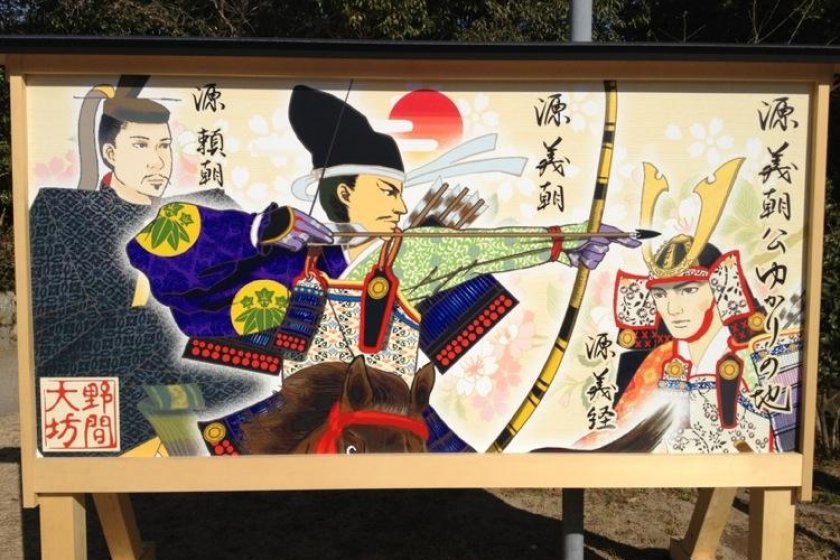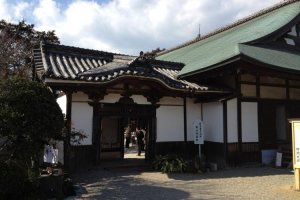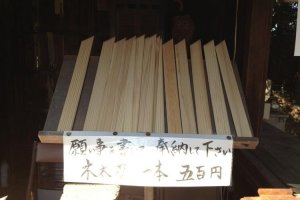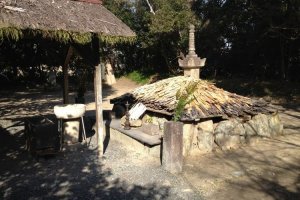In the sleepy region of Mihama Cho on the Chita Peninsula some 35 kilometers south of Nagoya City, stands a mid-seventh Century temple of the Shingon Buddhist sect. The ancient Omidoji Temple, also known as Noma Daibou is also famous for having been the site of the bath house where the great warrior, Minamoto no Yoshitomo, father of the first of the Kamakura Shogun, Yoritomo and Yoshitsune, was killed.
In 1159, the Minamoto and the Taira clans, once close, had become bitter enemies. Yoshitomo had been defeated in the Heiji Rebellion and fled the capital, Kyoto, for modern day Aichi Prefecture. Yoshitomo was staying in the village of Noma at the residence of one Osada Tadamune when the father-in-law of one of his retainers betrayed Yoshitomo to his enemies for a reward.
Having been informed of his whereabouts, Yoshitomo’s enemies attacked while the leader of the Minamoto Clan was taking a bath. Naked and unarmed, Yoshitomo was an easy target. Surrounded by the enemy, his last words were “If I had even a wooden sword…” before being slain. His head was taken and washed in a small pond nearby, which has since been known as the Chi No Ike, or Pond of Blood. The remains of the bathhouse itself can also still be seen.
The grave site, enclosed by a low stone wall, is located right alongside the temple’s main hall. Surrounding Yoshitomo’s central grave are the graves of his retainer, Kamata Masaie who on discovering the plot was stabbed twice by the traitor, and also that of the third son of Oda Nobunaga, Oda Nobutaka, who took his own life at Noma Daibou having been ousted from Gifu Castle in 1583.
Today, visitors to the noble warriors’ grave leave gifts of wooden swords in the belief that those who dedicate a sword will have their prayers answered. Because of this, the grave itself is always covered in a variety of wooden swords. To assist, a small kiosk sells small wooden sword shaped stakes for 500 yen, and supplies a felt pen with which to write ones wish and name before entering the grave precinct to offer the weapon. Similarly, the wooden votive tablets often seen at temples called “Ema”, decorated with pictures of the main worship hall or of Yoshitomo in action are also available and if not used to make requests of the deities, make great souvenirs at 500 Yen each too!
The Noma Daibou’s main worship hall, the Kyakuden, is designated an Important Cultural Property, and the Bonsho Prayer Hall is a Prefectural Cultural asset. The Prayer hall’s entrance way is of additional interest, as it was formerly a part of the reception hall at Momoyama Castle.
Between the Kyakuden and the Bonsho halls are a gate erected by Yorotomo in memory of his slain father, and a drum tower built by the Fifth Kamakura Shogun Yoritsugu in honor of his ancestor.
For history buffs, (read history freaks!) the Mihama area is surrounded by the remnants of many small civil war period castles, some of which have been reconstructed in concrete and make a great tour plan. (more details coming soon to this site!)
Noma Daibou retains a slightly spooky presence. This is where history happened. Not much seems to have changed in the 850 years since Minamoto No Yoshitomo fled here hoping to find sanctuary, only to lose his life. Life remains slow, and because of that, a visit to the area will leave you feeling so much closer to history and with a great story to tell.




































Interestingly baths are a leading cause of death in Japan, second only to traffic accidents. If Yoshitomo hadn't succumbed to sword cuts, he might just as well have fainted from the sudden heat and drowned like everybody else.
What a fascinating story.